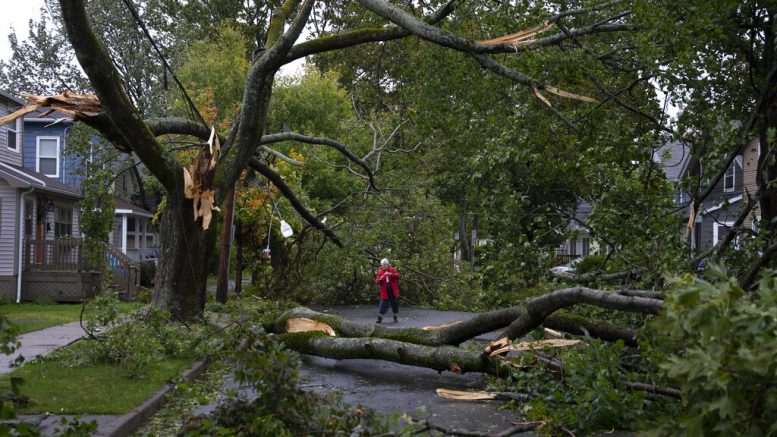HALIFAX, Nova Scotia (AP) — Fiona knocked out power to more than 500,000 customers in Atlantic Canada Saturday, damaging homes with strong winds and rain as it made landfall as a big, powerful post-tropical cyclone.
Fiona transformed from a hurricane into a post-tropical storm late Friday, but meteorologists cautioned that it still could have hurricane-strength winds and would bring drenching rains and huge waves.
More than 415,000 Nova Scotia Power customers — about 80% of the province of almost 1 million — were affected by outages Saturday morning. Over 82,000 customers in the province of Prince Edward Island were also without power, while NB Power in New Brunswick reported 44,329 were without electricity.
The fast-moving Fiona made Nova Scotia landfall before dawn Saturday, with its power down from the Category 4 strength it had early Friday when passing by Bermuda, though officials there reported no serious damage.
The Canadian Hurricane Centre tweeted early Saturday that Fiona has the lowest pressure ever recorded for a storm making landfall in Canada. Forecasters had warned it could be the one of the most powerful storms to hit the country.
A state of local emergency has been declared by the mayor and council of the Cape Breton Regional Municipality amid widespread power outages, road closures and damage to homes.
“There are homes that have been significantly damaged due to downed trees, big old trees falling down and causing significant damage. We’re also seeing houses that their roofs have completely torn off, windows breaking in. There is a huge amount of debris in the roadways,” Amanda McDougall, mayor of Cape Breton Regional Municipality, told The Associated Press
“There is a lot of damage to belongings and structures but no injuries to people as of this point. Again we’re still in the midst of this,” she said. “It’s still terrifying. I’m just sitting here in my living room and it feels like the patio doors are going to break in with those big gusts. It’s loud and it is shocking.”
McDougall said the shelter they opened was full overnight and they will look to open more.
. The federal Public Safety ministry advised against all non-essential travel by car.
A hurricane watch was issued for coastal expanses of Nova Scotia, Prince Edward Island and Newfoundland.
Prime Minister Justin Trudeau decided to delay his trip to Japan for the funeral for assassinated former Prime Minister Shinzo Abe.
“We of course hope there won’t be much needed, but we feel there probably will be,” Trudeau said. “Listen to the instructions of local authorities and hang in there for the next 24 hours.”
The U.S. hurricane center said Fiona had maximum sustained winds of 90 mph (150 kph) Saturday. It was moving across eastern Canada.
Hurricane-force winds extended outward up to 175 miles (280 kilometers) from the center and tropical storm-force winds extended outward up to 405 miles (650 kilometers).
Hurricanes in Canada are somewhat rare, in part because once the storms reach colder waters, they lose their main source of energy. But post-tropical cyclones still can have hurricane-strength winds, although they have a cold core and no visible eye. They also often lose their symmetric form and more resemble a comma.
“Just an incredibly strong storm as it made landfall. And even as it moves away it is continuing to affect the region for several more hours today,” said Ian Hubbard, meteorologist for the Canadian Hurricane Centre in Dartmouth, Nova Scotia, said Saturday morning.
“The talk of a historical storm definitely looks like it’s shaping up to be true.”
Hubbard said he lost power at his house and had to drive the long way to work because bridges have been closed. He said there are downed trees and signs in the Halifax area but other areas of province have it worse.
People in the area rushed to stock up essentials and worked to stormproof their properties Friday.
In Sydney, Nova Scotia, the largest city in Cape Breton, about 20 people have taken refuge at the Centre 200 sports and entertainment facility in Sydney, said Christina Lamey, a spokeswoman for the region.
“The key message from that is for people to stay at home,” she said. “The first responders are really stretched right now. We want people to stay off the roads. Most of the roads have hazards on them, with power lines down and trees down as well.”
Bob Robichaud, Warning Preparedness Meteorologist for the Canadian Hurricane Centre, said Fiona was shaping up to be a bigger storm system than Hurricane Juan, which caused extensive damage to the Halifax area in 2003.
He added that Fiona is about the same size as post-tropical storm Dorian in 2019. “But it is stronger than Dorian was,” he said. “It’s certainly going to be an historic, extreme event for eastern Canada.”
Officials on Prince Edward Island sent out an emergency alert to phones warning of the potential for severe flooding on the northern shore of the province.
Authorities in Nova Scotia also sent an emergency alert to phones warning of Fiona’s arrival and urging people to say inside, avoid the shore, charge devices and have enough supplies for at least 72 hours.
Fiona so far has been blamed for at least five deaths — two in Puerto Rico, two in the Dominican Republic and one in the French island of Guadeloupe.
Meanwhile, the National Hurricane Center said newly formed Tropical Storm Ian in the Caribbean was expected to keep strengthening and hit Cuba early Tuesday as a hurricane and then hit southern Florida early Wednesday.
It was centered about 315 miles (519 kilometers) southeast of Kingston, Jamaica. It had maximum sustained winds of 45 mph (75 kph) and was moving west-northwest at 14 mph (22 kph). A hurricane watch was issued for the Cayman Islands.
For more national and world news, visit TheDerrick.com.

























